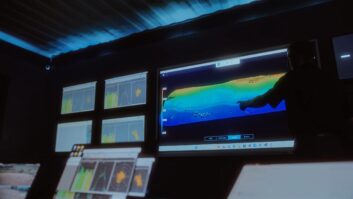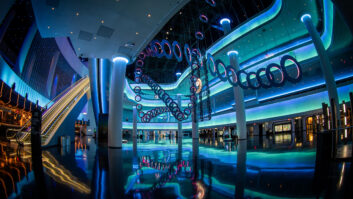
To fulfil its AVALON immersive 3D CAVE concept, Reynaers Aluminium asked Barco and Swedish integrator Nanco to come up with a five-sided solution within tight space constraints, reports Rob Lane.
When Reynaers Aluminium, the global Belgium-headquartered specialist in innovative and sustainable aluminium solutions for windows, doors and conservatories, wanted a high-tech visualisation system for demonstrating its products, it turned to Barco and Swedish integrator Nanco.
The intention was to develop a system that would enable the enhancement of communication and collaboration with its partners within its upgraded headquarters in Duffel, Belgium. The system would have to show Reynaers’ CAD models of private homes, large buildings and so on, with large 3D models being available for viewing by several people at a time. Viewers would need to be able to stand outside as well as inside the virtual buildings, and look around and move within them.
Reynaers decided on a CAVE (cave automatic virtual environment) solution, where architects, contractors and investors would be able to step in and view, evaluate and change almost any type of 3D model within a virtual reality environment, virtually integrating Reynaers’ building solutions into their own concepts. The CAVE had to facilitate the decision-making process, with easy, real-time fine-tuning of the designs.
Full immersion
For the concept to work, full immersion was key, and that meant a five-sided (4.8m x 3.3m x 2.5m) CAVE, including ceiling projection – tricky even without the various challenges the space put in the way. Housed within the Reynaers Campus, a high-tech, digitally enabled experience centre, the CAVE required roof imagery so that users could look up at the virtual architectural model or within the model, and floor projection to create the experience of standing inside or outside the model. The front screen of the CAVE could then be used as a ‘2D powerwall’ for presentation when required.
AVALON allows visitors to experience future buildings through a shared virtual reality experience – a 3D evaluation of buildings and solutions – and radically changes the way the design of a building is evaluated and visualised.
Based around customised Barco Overview OL-721 LED rear-projection videowall modules, alongside an F35 laser phosphor projector for the floor projection – the first time an F35 had been used in a CAVE installation – the high-end projection-based VR room is specifically configured for architectural applications for groups of up to eight people. Active 3D glasses create a stereoscopic image and track user movements, generating the 3D illusion but still allowing users to see and interact with other participants. Audio is carried by JBL speakers, in stereo in the ceiling of the CAVE and a 5.2 system in the Audience Room.
Nanco customised the Overview rear-projection units by mounting them without their boxes, instead using multiple projectors projecting onto all four sides of the CAVE (leaving the floor for the F35). So, for example, the front screen utilises nine overlapping projectors with images blending seamlessly together.
AVALON’s powerful cluster of computers can handle complex architectural models and process the real-time rendering. Files from over 200 commonly used applications can be displayed as high-quality, fully navigable virtual models. While the user navigates through the model with a control stick, the operator can make real-time changes to the design software.

The CAVE’s technical challenge here was that there was no cellar below it in which to install the Barco F35 floor projector. Nanco had a solution: instead of projecting from underneath the floor, the ‘from below’ projection would come from above. Easy enough, perhaps, if it hadn’t been for the need for roof projection as well!
The solution was a compromise, to create a partial roof projection to allow space for a full floor projection: a 4.80m x 0.90m roof projection was more than adequate, leaving enough roof space for a full floor projection.
“We set up a floor projector in the usual way, with a placement in the ceiling projecting the floor image from above, plus a ceiling image covering the first metre out from the front wall,” explains Mats Nilsson, sales manager at Nanco. “With this you get the floor image you need, plus if you are standing in front of the front screen, you can look up and see very tall buildings, due to the ceiling image.”
Space constraints
Another challenge was the available space. Reynaers’ office architects limited the area for the CAVE to a minimum, leaving only a narrow space where multiple projectors, computers and a cooling system had to co-exist. To make matters worse, cooling engineers pointed out that there would be technical problems in effectively cooling down the entire set-up in such a cramped space.
As the limited space was needed for the projectors, the computers, racks and the cooling system were located in the basement, situated under the adjacent building. This of course radically increased the distance between computers and the projectors – too long for HDMI cables. Consequently, the only solution was to install fibre optics and signal amplifiers between the CAVE and basement.
In June 2017 the AVALON CAVE was complete. Utilising the customised Overviews, it comprises 12 side rear-projectors, nine front rear-projectors, two roof rear-projectors and the F35 for floor projection. The visualisation solution includes a tracking system and 3D glasses to fully immerse the viewer. To manage large 3D architectural models and to reduce the amount of conversions, thus meeting the demand of software flexibility, TechViz software was installed. The software was customised enabling up to eight different application systems, hand-picked by Reynaers. But overall this was a team effort.
“This was a little bit of a special case,” says Nilssen. “Nanco is an integrator that combines all kinds of different hardware and software into a final, in many cases turnkey solution. Usually we have a quite high influence on selected technology, in co-operation with the end customer.
“In this case it was a combined effort where Barco was responsible for the display part, and we were responsible for all other parts: computers, signal distribution, tracking system, audio system, control system and software.
“In most cases the customers tell us what they want to have (function wise), and we propose a technical solution, in combination with a budget and a discussion with the customer. Before we started [on the AVALON installation] the customer had been visiting several similar [3D CAVE] sites, either together with Barco, with us or in a combination – customer, Barco, Nanco.”
Nanco is no stranger to multiple projector installations, and has done similarly challenging large CAVE projects. However, it was the Swedish company’s first multi-purpose CAVE, allowing the possibility of using the front screen as a 2D system – other CAVEs are set up to always use all of the sides every time. And, ultimately, the 25-projector system – and the space constraints within AVALON – made this one of the company’s most complex installations.
www.ar-tracking.com
www.barco.com
www.dell.com
www.integrahometheater.com
www.jblpro.com
www.kramerav.com
www.nanco.se
www.nextron.no
www.reynaers.com
www.techviz.net
www.volfoni.com







